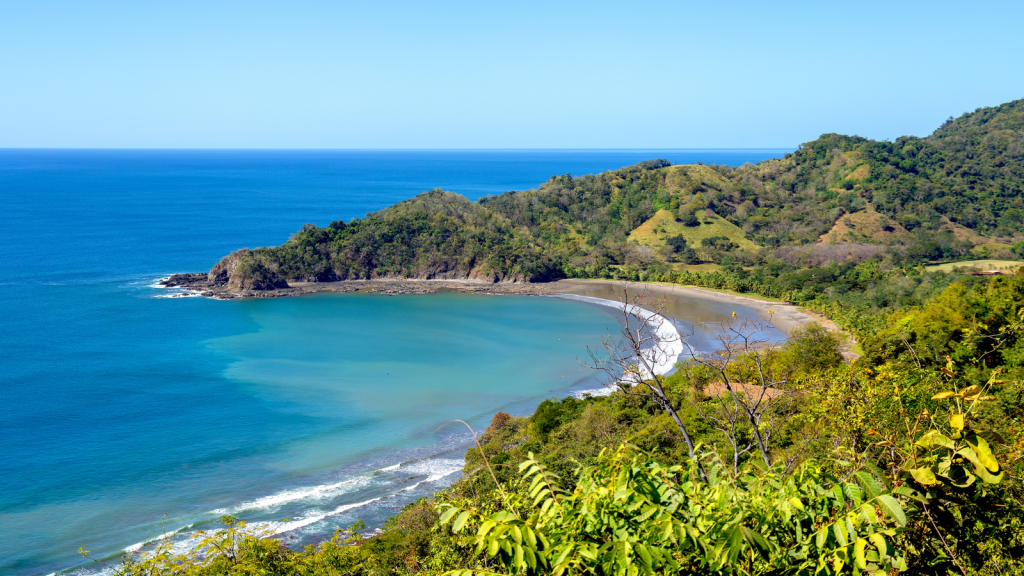When Is The Best Time To Travel To Costa Rica, Guanacaste?

Welcome to Central America’s hidden gem, Costa Rica’s Guanacaste region, also known as the hottest part of the country. Here, natural wonders and cultural delights await visitors from around the globe.
Located in the northwestern corner of the country, Guanacaste is popular for its stunning beaches, diverse ecosystems, and warm hospitality. Whether seeking adventure, relaxation, or cultural immersion, Guanacaste offers fun experiences to satisfy every traveler’s desires.
Understanding Guanacaste’s Climate
Guanacaste’s climate is characterized by its tropical nature, with distinct seasons shaping the region’s landscape and atmosphere. Costa Rica’s geographical location near the equator influences its climate, resulting in consistent high temperatures year-round. The dry season typically spans from December to April, while the rainy season extends from May to November.
Seasons in Guanacaste
The dry season, known locally as “Verano” (summer), is a great time to visit Guanacaste due to its sunny skies and minimal rainfall. This period is ideal for beach activities, outdoor adventures, and exploring the region’s natural attractions—generally the peak season for tourists.
In contrast, the rainy season, called “invierno” (winter), brings rich vegetation and occasional showers, creating a very green landscape. While the rainy season may be a hassle for some travelers, it offers unique opportunities for wildlife observation, cultural experiences, and discounted accommodations.
Peak Tourist Seasons
The high season in Guanacaste, which coincides with the dry season, attracts many tourists seeking warm weather and white sand beaches. Accommodation prices are higher during this period, and popular attractions may experience crowds.
On the other hand, the low season, occurring during the onset of days of rain offers quieter beach time, lower accommodation rates and car rentals, and opportunities for budget-friendly travel. Travelers can enjoy similar experiences to high-season visitors while benefiting from fewer crowds and more affordable prices.
Temperature Matters
Guanacaste’s climate features warm temperatures with some little rain year-round, making it an ideal destination for beach lovers and outdoor adventurers. Understanding the complexities of temperature variations throughout the day and between seasons can enhance your travel experience when you visit Costa Rica.
Balmy Beach Days

Aside from its tropical climate, one of the main attractions of Guanacaste is its stunning coastline, boasting pristine beaches with plenty of sunshine. During the dry season, typically from December to April, beachgoers can expect hot temperatures perfect for lounging by the shore or engaging in water sports. Daytime highs often reach the mid-80s to low 90s Fahrenheit (29-35°C), giving a better time for sunbathing, swimming, and surfing.
Navigating Cooler Evenings
While Guanacaste enjoys the best weather year-round, evenings and early mornings can bring cooler temperatures, especially during the dry season and at higher elevations. As the sun sets over the Pacific Ocean, coastal breezes may bring a refreshing chill to the air, requiring travelers to pack accordingly for cooler evenings.
Light layers such as long-sleeved shirts, sweaters, or jackets are recommended to stay comfortable during outdoor activities or evening strolls. Moreover, inland and mountainous regions may experience cooler temperatures, so it’s advisable to check weather forecasts and pack appropriately if going into these areas.
Wildlife Encounters
To maximize your chances of observing Guanacaste’s diverse wildlife, it’s essential to consider the best times of year for viewing specific species and natural phenomena. The dry season, which runs from December to April, is an excellent time for wildlife observation, as animals go near water sources and are more active during the day. This period offers ideal conditions for spotting iconic species such as howler monkeys, white-faced capuchins, and colorful toucans in their natural habitats.
However, the rainy season, from May to November, presents unique opportunities for wildlife enthusiasts. While frequent rain showers may not be perfect for some travelers, the abundant vegetation and increased water availability attract many species, including amphibians, reptiles, and migratory birds.
Special Migrations and Nesting
Guanacaste’s natural calendar is marked by special migrations, nesting events, and other seasonal phenomena that showcase the region’s ecological wonders. One notable example is the annual arrival of humpback whales along the Pacific coast, which occurs from December to April during their migration from feeding grounds in Antarctica to breeding grounds in the warm waters of Costa Rica.
Another highlight of Guanacaste’s wildlife calendar is the nesting season of sea turtles along the region’s beaches. Olive ridley, green, and leatherback turtles are among the species that return to Guanacaste’s shores to lay their eggs, typically from July to December.
Festivals and Celebrations
Guanacaste’s colorful cultural scene comes alive throughout the year with a calendar filled with colorful festivals and lively celebrations. These events offer visitors a unique opportunity to enjoy themselves fully in the region’s rich traditions, music, dance, and culinary delights, providing insight into Costa Rican culture and heritage.
Cultural Extravaganzas
Guanacaste hosts various religious festivals throughout the year, such as the Fiesta de San Juan, Fiesta de la Virgen del Mar, and Semana Santa (Holy Week). These festivals feature processions, mass ceremonies, and traditional rituals that reflect the region’s deep Catholic faith and spiritual traditions. These celebrations offer visitors a glimpse into the religious customs and beliefs that have shaped Guanacaste’s cultural identity for centuries.
Planning Around Festive Times
When planning your visit to Guanacaste, you may time your trip to coincide with festive times, allowing you to participate in local celebrations and cultural extravaganzas. Joining festivals such as the Fiestas Civicas or the Festival Internacional de la Cultura Liberia provides a unique opportunity to get involved in Costa Rican culture, interact with locals, and experience the life of Guanacaste’s traditional arts and customs.
Water Activities Galore

Guanacaste’s pristine coastline and crystal-clear waters beckon water enthusiasts worldwide to indulge in various aquatic adventures. From world-class surfing to mesmerizing snorkeling and scuba diving, there’s no shortage of ways to explore the region’s marine wonders and coastal beauty.
Surf’s Up All Year?
Guanacaste boasts some of Costa Rica’s best surf spots, catering to surfers of all skill levels, from beginners to experienced riders. With consistent waves, warm water temperatures, and stunning beach breaks, the region offers ideal conditions for surfing year-round. Playa Tamarindo is a popular hub for surfers, known for its consistent waves and vibrant surf culture.
It is a great place for newbies to take lessons from local surf schools, while more experienced surfers can test their skills at well-known breaks such as Witch’s Rock and Ollie’s Point. Aside from surfing, Guanacaste offers plenty of aquatic activities for adventure seekers and nature lovers. Snorkeling enthusiasts can explore amazing coral reefs, tropical fish, and marine life in the region’s protected marine areas, such as the Catalinas Islands and the Bat Islands.
You can also participate in scuba diving sessions to explore Guanacaste’s underwater landscapes and encounter diverse marine species. Other water-based activities include stand-up paddleboarding, kayaking, and fishing.
Lush Green Landscapes
During the rainy season, which typically runs from May to November, Guanacaste bursts into the magnificence of green as the landscape comes alive evidently. Lush vegetation blankets the hillsides, rainforests are visible with moisture, and rivers swell with cascading waterfalls. The region’s huge ecosystems thrive under the nourishing rains, creating a picturesque view for outdoor adventures and nature exploration.
However, from December to April, the dry season transforms Guanacaste’s scenery with a golden hue, exposing the landscape to the sun’s warm glow. During the dry season, there might not be as many plants around compared to the rainy season, but the clear skies and sunlit vistas create photo-worthy moments at every turn. Beaches stretch out beneath clear blue skies, being beautified more by swaying palm trees and rocky outcrops.
Choosing Accommodations Wisely

During peak tourist seasons, such as the dry season from December to April, accommodation prices in Guanacaste are high due to high demand. To take advantage of lower accommodation prices during this time, consider booking your accommodations well in advance to take advantage of early booking discounts and promotional offers.
Be flexible with your travel dates and consider visiting Guanacaste during the shoulder months of the dry season, such as November or May, when prices may be lower and crowds are less. Exploring alternative lodging options, such as guesthouses, hostels, or vacation rentals, can also help stretch your travel budget without compromising comfort or convenience.
Off-Peak Luxury Retreats
Travelers seeking luxury without breaking the bank can take advantage of off-peak seasons to relax in premium accommodations at discounted rates. During the rainy season, from May to November, luxury resorts and boutique hotels in Guanacaste may offer special promotions and package deals to attract guests during quieter months. Take advantage of these off-peak offers to enjoy luxurious amenities, spa treatments, and personalized services at a fraction of the cost compared to high season rates.
Local Cuisine Delights
Guanacaste’s cuisine is deeply influenced by the region’s climate and agricultural cycles, resulting in seasonal variations in ingredients and flavors. During the rainy season, from May to November, the prevalence of heavy rain nourishes the land, yielding an abundance of fresh fruits, vegetables, and herbs. This time of year sees an abundance of tropical fruits such as mangoes, papayas, and pineapples, as well as root vegetables like yuca and plantains. Local chefs and home cooks use these seasonal ingredients to create flavorful dishes celebrating the region’s bounty.
However, Costa Rica’s dry season brings drier weather and various crops from December to April. While some fruits may be less abundant during this time, other ingredients such as tomatoes, peppers, and herbs thrive in the warmer temperatures. Guanacaste’s cuisine during the dry season often features grilled meats, fresh salads, and more that complement the sunny weather and outdoor dining experiences.
Farmers’ Markets and Fresh Finds
One of the best things about Guanacaste is its local food products. Be sure to visit the region’s farmers’ markets and roadside stands. These exciting markets showcase a colorful selection of fruits, vegetables, herbs, and spices sourced directly from local farmers and producers.
Exploring Guanacaste’s Hidden Gems
While Guanacaste is known for its popular tourist attractions and mesmerizing beach areas, exploring exciting paths reveals hidden gems that showcase the region’s natural beauty and cultural heritage. One such hidden treasure is the town of Santa Cruz, located in the center of Guanacaste’s countryside. Here, visitors can stroll through the town’s photo-worthy streets, visit local markets, and explore historic sites such as the Santa Cruz Church and the Museo de Arte Guanacasteco, which showcases indigenous art and artifacts.
Tenorio Volcano National Park offers a glimpse into Guanacaste’s wild side if you plan to visit national parks. This remote park is home to the stunning Rio Celeste waterfall, known for its turquoise waters and surrounding rainforest scenery. Hiking trails lead through lush jungles, volcanic landscapes, and bubbling hot springs, providing opportunities for wildlife viewing and birdwatching along the way.
Insider Tips for Every Season
Local residents of Guanacaste offer valuable insider tips for travelers seeking a good time in the area. During the dry season, from the end of November to April, locals recommend exploring the region’s lesser-popular beaches, such as Playa Rajada and Playa Naranjo, which offer tranquil shores and uncrowded surf breaks. Moreover, visiting inland towns such as Liberia and Bagaces allows travelers to experience Guanacaste’s cultural heritage and rural charm away from the tourist crowds.
During the rainy season, from May to November, locals suggest visiting waterfalls and natural attractions at their peak. Places like Llanos de Cortés waterfall near Bagaces and the Rincon de la Vieja National Park offer beautiful landscapes and opportunities for adventure, including hiking, zip-lining, and horseback riding.
Practical Travel Tips
Before going on a trip to Guanacaste, it’s essential to familiarize yourself with Costa Rica’s visa requirements and entry regulations. Citizens of many countries, including the United States, Canada, and the European Union, do not require a visa for stays of up to 90 days for tourism purposes. However, travelers should ensure their passport is valid for at least six months beyond their intended departure date and have proof of onward travel, such as a return airline ticket or itinerary.
Upon arrival in Costa Rica, travelers must present a valid passport, complete a customs declaration form, and pass through immigration and customs checkpoints. Furthermore, all travelers must have travel insurance covering medical expenses and emergency medical evacuation during their stay.
Health and Safety Precautions
While Guanacaste is a relatively safe destination for travelers, taking precautions to protect your health and well-being during your trip is advisable. Before traveling, ensure you are up-to-date on routine vaccinations, including measles, mumps, rubella, and tetanus. Also consider getting vaccinated against hepatitis A and typhoid, especially if you plan to engage in outdoor activities or eat street food.
Guanacaste is generally considered safe for travelers, but it’s essential to exercise caution and be vigilant, especially in tourist areas where petty theft and scams may occur. Keep your valuables secure, avoid displaying expensive items, and use reputable transportation services when traveling around the region.
Conclusion
The ideal time to travel to Costa Rica’s Guanacaste region depends on your preferences and what you hope to experience during your trip. The dry season offers sunny skies and less rain from December to April, perfect for beach activities and outdoor adventures. By considering factors such as weather, tourist seasons, and local insights, you can plan a memorable and enjoyable journey to this lovely destination.
So pack your bags, prepare for an adventure, and get ready to experience the beauty and charm of Guanacaste, Costa Rica. Your perfect time awaits in this hidden gem of Central America.

